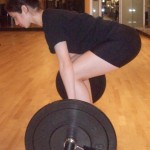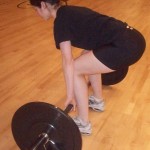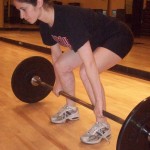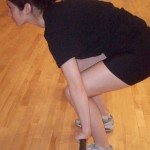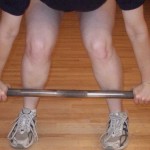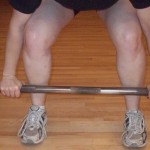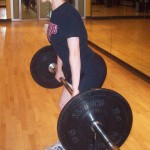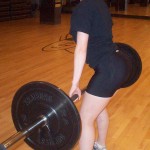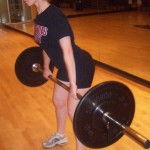Recently I had a discussion (on my end – a very heated argument on his end) with a coworker who is a sub-par personal trainer. Degrees in kinesiology do not always a great personal trainer make…. Anyway, we were debating the proper way to complete a deadlift. All of the misinformation that was floating around has prompted this post – to inoculate you readers against the idiocy I experienced last week.
Starting Form
Follow these points to have the proper bottom position for a standard (not sumo or other variation) deadlift.
- Line your feet up between hip and shoulder width apart, toes pointed forward to no more than 30 degrees of outward rotation.
- Bend forward and grasp the bar with an overhand grip. Grip width should be placed so that your hands are directly outside your legs, but not so tight that they prevent your knees from staying in line with your toes when bent.
- Pull the bar to your shins so it lies over your midfoot, and pull your hips down. Keep your entire back flat (extended upper and lower back). Your hips will not be as low as in a squat – your thighs will not be parallel to the ground. Hips should be slightly higher than knees.
- Your shoulders should be positioned slightly in front of the bar. Arms should be straight.
- Chest should be up and your neck should be neutral (in line with your chest – not looking up or down).
- Pinch your shoulder blades down and back, and keep them this way for the entire lift.
- Your lower legs should be approximately perpendicular to the ground, not angled far forward as in the squat. It will be difficult to keep your balance without continuing to pull the weighted bar into your shins and also applying a small amount of upward force.
The Pull
- Take a deep breath and hold it (a Valsalva manuever) prior to the pull. A small amount of air will be released at the top of the pull, but do not deflate your torso or you will lose stability.
- Begin pulling off the floor by straightening the knees only enough for the bar to clear them in a vertical line. Think about squeezing the weight up to prevent jerking the bar off the ground and losing form.
- The bar should maintain contact with your legs for the entire lift and should travel in a straight vertical line.
- Once past the knees, continuing pulling the bar directly vertically by simultaneously straightening your knees and hips. Your back should have been straight the entire time so I will not tell you to straighten it.
- Knees and hips should finish together – that means your knees open at a slower rate than your hips.
The Finish
- Finish with the bar hanging from the hands, against the thighs/hips, body fully erect.
- If your goal was only to lift the weight (concentric exercise) – and you are using bumper plates on a safe surface – you can now carefully drop the weight as you take a step back.
- If you want to perform the eccentric part of the exercise (not necessary with very heavy attempts) or you are using metal plates, you will also be lowering the weight. Make sure shoulder blades are still down and back, neck is still neutral, lower back is still flat. Push your hips back while unlocking but not bending your knees. Keep the bar pressed against your legs. When the bar is approximately at knee height, start bending your knees and continue bending hips. Lower legs should not angle too far forward. You should end up in the same position you started in.
- At no point should you relax and allow your lower back to round. Injuries happen when lifters are tired from a set and lazy and don’t maintain form when putting the weight back down.
- Sideview Starting Position
- Backview Starting Position
- Front View Starting Position
- Incorrect Back Posture
- Incorrect Knee Position
- Correct Knee Position
- Side View of Midstance
- Back View of Midstance
- Front View of Midstance

